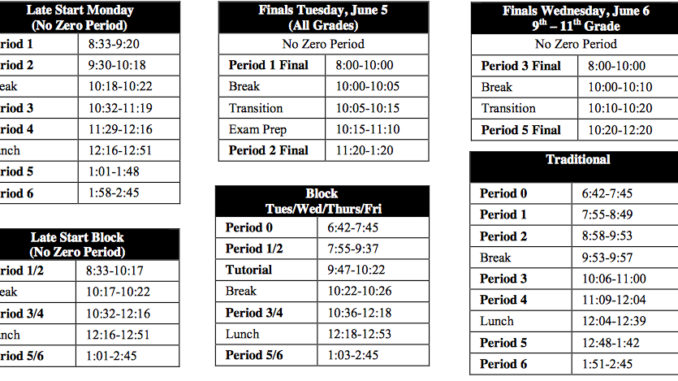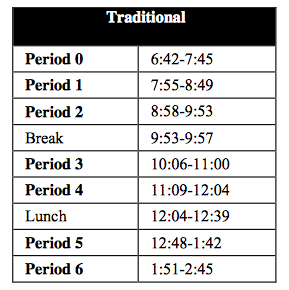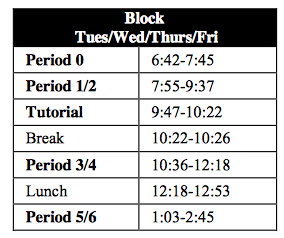
By: Zoe Day | News Editor
Wednesday, May 9, 2018
Time at school can feel warped. Some days, a single period can seem to stretch for hours. Other days, it feels like there is never enough time to get everything done in a single sitting. San Clemente High School recently switched from a two-day block schedule to a four-day block schedule, and the results of this year-long trial will determine the future of the block schedule at SCHS.

Block periods cut the school day into chunks with fewer classes and longer periods each day. Instead of cycling between six classes for 50 minutes each, block periods carve out an hour and forty minutes for each class. Block days cut out three nine-minute passing periods and include a tutorial period, where students have the opportunity to catch up on work or ask for extra help. Block days help teachers plan out more engaging activities, and it can be easier to start and finish an entire lesson plan as opposed to the traditional schedule, where classes pass quickly. Nevertheless, there are complaints that it’s harder for students to focus in long classes, and some teachers struggle to fill the almost two hour period. Some teachers in subjects like math and foreign language complain that only seeing their students three times a week is detrimental to their learning.
SCHS was the last school in the Capistrano Unified School District to switch to a four-day block schedule. In past years, the schedule at SCHS consisted of traditional days on Mondays, Thursdays, and Fridays, with two block day schedules on Tuesday and Wednesday. Last year, SCHS fought to win a 60% approval to try out the four-day block schedule and eventually won. Interestingly, the verdict of which schedule to use has been largely left to the teachers. Last year’s vote solely took into account teachers’ votes with the argument that teachers stay long-term, while students are only here for four years. Aren’t the students the ones learning? Shouldn’t the schedule be determined by students’ learning styles? This year, administration offered a student survey to collect data about student responses to the new four-day block schedule after almost a year into the trial. As the first year of the four-day block trial comes to a close, teachers reconvened to vote on the future of the block-day schedule.

The trial run of the four-day block schedule has had mixed results. Despite the initial resistance to the switch, many students have found that the new schedule allows them more freedom to manage their time, especially when balancing rigorous classes with extracurriculars, sports, and other responsibilities. Junior Indy Day, an IB Diploma Candidate, stated that the four-day block schedule “is a blessing” and endorsed it as “the best invention since sliced bread.” Tests are more spaced out, and students are able to focus on one subject at a time, instead of quickly switching classrooms without really having time to be productive. Since students only have each of their classes every other day, they are able to manage homework and other assignments, instilling time management skills. Ashley Echelberger, a senior at SCHS, is a fan of the new block day schedule because “the alternating block days allow more time for homework and take some of the stress out of school.” Nevertheless, Echelberger acknowledged the downside of the schedule change, “the block days feel very long, causing students to get tired and bored easily.” While these longer classes can be harder to endure, they better prepare students for the long lectures they will realistically encounter in college classes. The boredom factor also depends on how teachers run their classes; some teachers simply teach two days’ worth of lessons back to back, which runs the risk of tiring students, while other teachers have embraced the block day schedule as an opportunity to mix up their classes with different types of activities to keep their students engaged.
The four-day block schedule switch came with another change: assigned tutorials. In the place of two free tutorials in past years where students were free to go to any of their teachers to ask for help or work on homework, this year’s schedule introduced three assigned tutorials for every free tutorial each week. While the assigned tutorials are a more efficient way of keeping track of student attendance and avoiding overcrowded tutorials, they take away the freedom for students to actually go and get help when they need it. Tutorials are not to be used for instructional minutes, but teachers and students are still figuring out how to maximize efficiency during these periods. Tutorials are also utilized to make up tests or participation after absences, so it can be a hassle to get a slip to go to a teacher other than the one assigned on a given day. If the four-day block schedule stays, it is likely that there will be changes and improvements made to the tutorial system.
Change can be scary. The idea of a four-day block schedule initially encountered resistance in that it would force teachers to make adjustments to their teaching style, threatening tradition. In its first year, the four-day block schedule has shown tremendous success in the classrooms that have made accomodations for the switch. The future of the block schedule isn’t yet set in stone, but it seems to be moving in the right direction.

Personally, I think I’m perfectly content with this block schedule…
But to any CUSD staff members reading this, who thought assigned tutorials are a good idea?